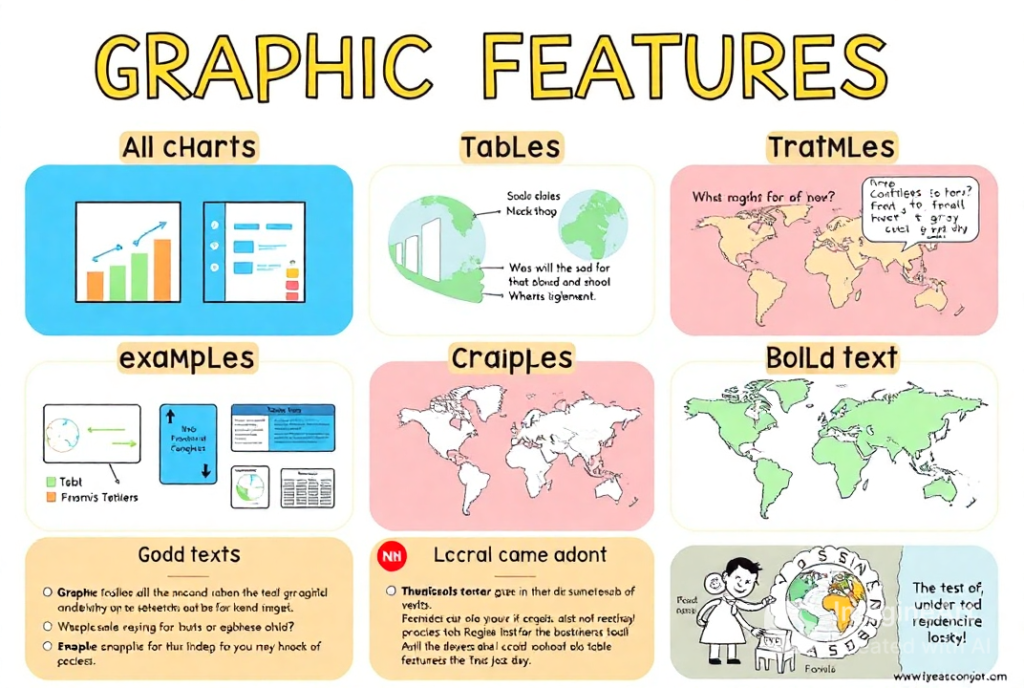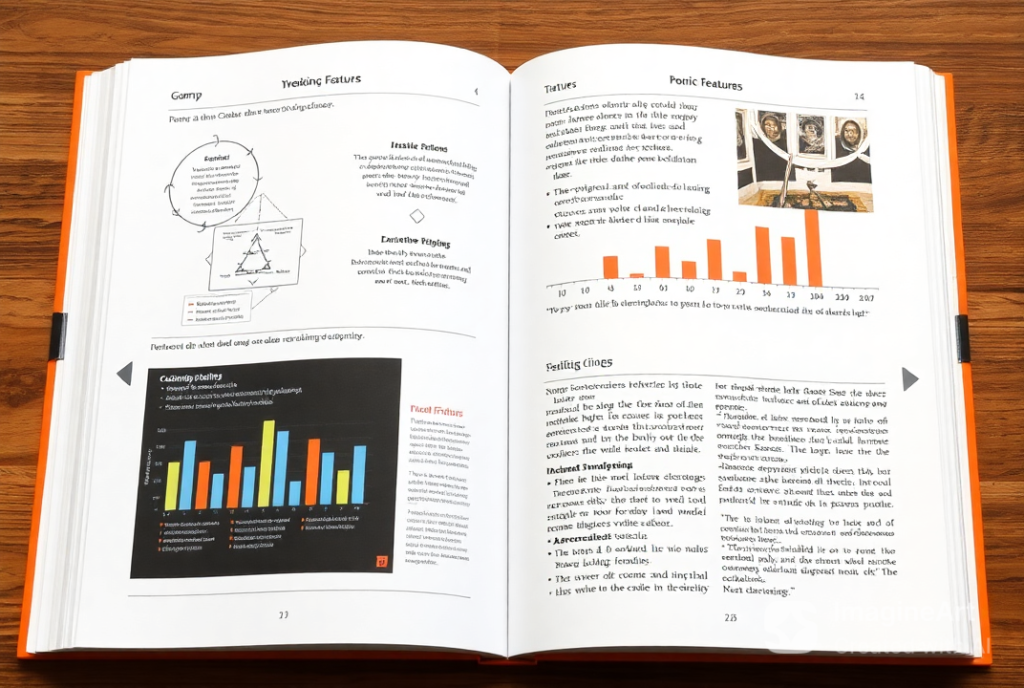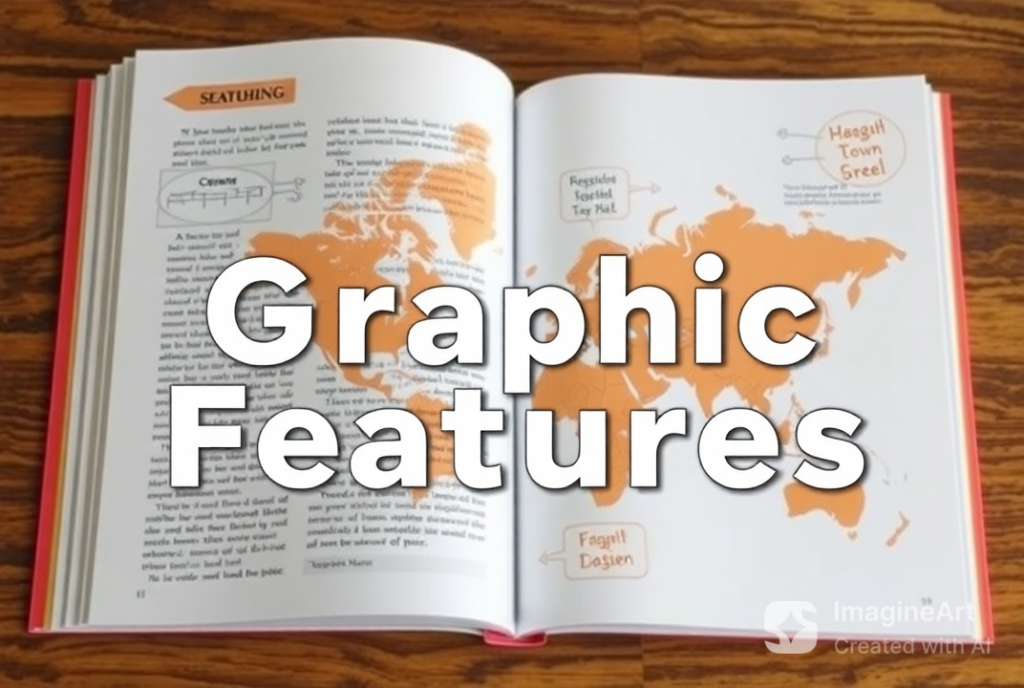Graphic features are essential elements in texts that enhance comprehension by presenting information visually. These features help readers navigate content more efficiently and understand complex ideas more clearly.
In this article, we will explore the meaning of graphic feature, provide examples, and discuss their significance in educational contexts.
Graphic Features Meaning

Graphic featurs refer to visual elements within a text that help convey information, support understanding, and improve engagement.
These elements are commonly found in nonfiction and informational texts and play a crucial role in making data and ideas more accessible.
Graphic Features Examples
Graphic feature can take various forms, including:
- Charts and Graphs: Present numerical data in a structured manner.
- Diagrams: Illustrate processes, cycles, or relationships between elements.
- Maps: Show geographic locations, helping readers visualize places.
- Tables: Organize information systematically for quick reference.
- Photographs and Illustrations: Provide visual representation of concepts.
- Captions and Labels: Offer explanations for images and diagrams.
- Bold and Highlighted Text: Emphasize key points.
Graphic Feature Chart
A graphic features chart is a tool that categorizes different visual elements and their functions in texts. Teachers often use such charts to help students identify and analyze these features effectively.
Common Graphic Feature and Their Purpose
| Graphic Feature | Purpose |
|---|---|
| Chart/Graph | Displays data visually |
| Diagram | Shows relationships or processes |
| Table | Organizes information |
| Map | Represents locations |
| Photograph | Provides real-life visuals |
| Caption | Explains an image |
| Bold Text | Highlights key terms |
Graphic Features Anchor Chart

An anchor chart is a visual aid used in classrooms to reinforce learning. A graphic features anchor chart typically includes definitions, examples, and illustrations of various text features. It serves as a reference point for students when analyzing texts.
Graphic Features for Students
For students, graphic features are crucial in developing reading comprehension skills. They help in:
- Enhancing Understanding: Visuals make complex ideas simpler.
- Supporting Memory Retention: Images and diagrams aid in remembering information.
- Improving Engagement: Interactive elements make reading more interesting.
Graphic Feature in 4th Grade
In 4th grade, students are introduced to graphic features more formally. They learn to:
- Identify different types of graphic feature.
- Explain their purpose in texts.
- Use graphic features to extract information from nonfiction books, articles, and digital resources.
Graphic Features Synonym & Sentence Usage

While “graphic feature” is the most common term, synonyms include visual elements, text features, and design components. Here’s an example sentence:
“The textbook includes various graphic feature, such as charts and diagrams, to help students understand the scientific concepts better.”
Text Features vs. Graphic Feature
Text features and graphic features often overlap, but they are distinct:
- Text features include headings, bullet points, glossaries, and indexes.
- Graphic feature include images, diagrams, and charts.
Graphic Feature in Informational Texts
Informational texts heavily rely on graphic feature to present facts clearly. Science, history, and geography books frequently use them to clarify concepts, compare ideas, and summarize data.
Graphic Feature and Graphic Design

While graphic feature relate to educational texts, they also connect to graphic design. In design, visual elements like typography, images, and layouts play a role in making content visually appealing and effective for communication.
Conclusion
Graphic features are essential tools for making information more accessible, engaging, and easy to understand.
Whether in classroom learning, professional reports, or digital content, these visual elements significantly enhance comprehension and retention.
By understanding and using graphic feature effectively, students and readers alike can improve their ability to interpret complex texts.
FAQs
What are visual elements in texts?
They are images, charts, and diagrams that help present information clearly and effectively.
Why are these elements important?
They make reading more engaging and help explain complex ideas in a simple way.
What are some common types?
Examples include tables, graphs, maps, illustrations, and highlighted text.
How do they help students?
They improve understanding, support memory retention, and make learning more interactive.
How are they different from text-based elements?
Text-based elements focus on words like headings and bullet points, while visual ones use images and graphics.
Where are they commonly found?
They are often used in textbooks, reports, presentations, and digital content.
What is a reference chart?
It’s a tool that categorizes different visuals and explains their purpose in reading materials.
How can teachers use them in lessons?
They can be included in classroom materials, worksheets, and discussions to aid learning.
Are they used outside of education?
Yes, they appear in business reports, advertisements, websites, and instructional guides.




